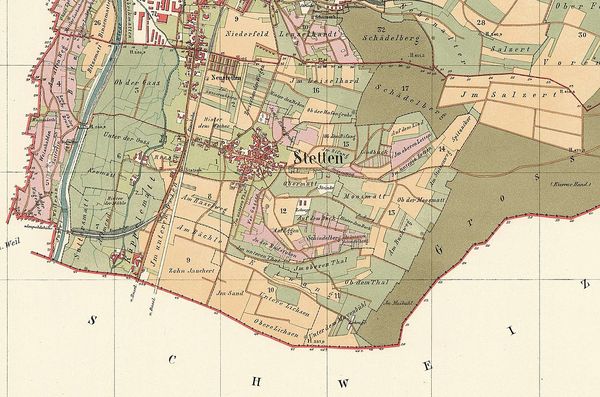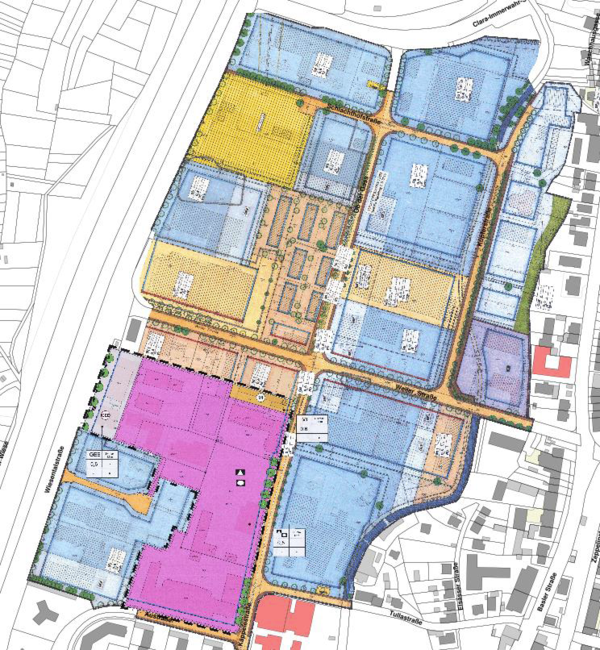Location
The mixed-use industrial zone "Ob der Gass" is located in the district of Stetten. It is part of the industrial strip in Wiesevorland located between the Innocel district and the border with Switzerland.
In the north, the zone is bounded by the Clara-Immerwahr-Straße link road, and, in the south, by Austraße and Tullastraße roads. The Wuhrgenossenschaft Tumringen-Lörrach commercial channel, which is dammed in between Schlachthofstraße and Weiler Straße, forms the border to the east, with Wiesentalstraße (B 317/"duty-free road") forming the border to the west. The name of the industrial park and some roads in the area are derived from the former furlong names, "Ob der Gass", "Unter der Gass", "Neumatt" and "Käppelematt".

History
Colonisation of the floodplain only became possible after the river straightened in the meadow in the wake of the Tulla Rhine correction in the 19th century. When August Engisch from Basel founded his silk yarn factory in 1870 (later: Ruvera silk thread factory), the
area was still mostly unpopulated. The area lay at the gates of the municipality of Stetten, which became part of the town of Lörrach in 1908 through incorporation. A little further south on the commercial canal on the site of what is "Neumattschule" today, lay Brogle Mill, while one of the ice-covered ponds from Lasser Brewery was located north of Weiler Straße.

In the 20th Century, besides the textile industry (Engisch, satellite warehouse
KBC), textile dyes (Sandoz / Clariant), meat processing (WUFA/smoked ham Einhaus, Kalbacher, slaughterhouse (until 2018)), metalworking (NSI Präzisionsdrehteile since 1934) and mechanical engineering (Walter Kraumendahl 1962-1992) in the manufacturing sector were formative for the industrial park.
Development plan: "Ob der Gass II"
The commercial zone was first planned in 1958 and established as an enterprise zone. The development plan from 1967, which for the most part was established as an unrestricted level III enterprise zone, was abolished in 1986. In the development plan from 1997, which incorporated the results of a model investigation by the Baden-Württemberg Ministry of the Interior in coordination with the Chamber of Architects and Association of German Architects, the planning area was mainly established as a commercial park (GE, GEE). The slaughterhouse and the meat processing company Kalbacher received a qualified, extended provision.
The residential island on "Ob der Gass" street and partial areas along "Weiler Straße" street were designated as a mixed zone (Ml). At the interfaces to the mixed zone, uses in the restricted commercial zone (GEE) are only permitted if they do not significantly disturb residential living.
A special area was designated for the furniture market on "Weiler Straße". The substation in the northern sections is designated as an area for supply systems, while the main fire station in Lörrach and the integrated control centre from the German Red Cross (DRK) are designated as areas for common use. This has applied since 2011 ("Ob der Gass Il, Amendment 2"), as well as for the entire area where the Free Evangelical School (FES) is located.

Goals of the commercial space development concept (2017)
- Safeguarding commercial use
- no further conversion towards residential, retail or land for common use.
- Upgrade to the appearance
- Activation of underused space
- Examination of private owners' intentions to exploit
Contact:



